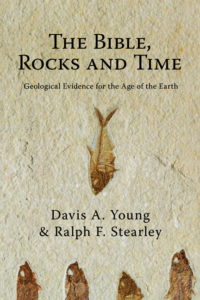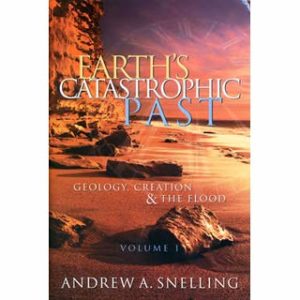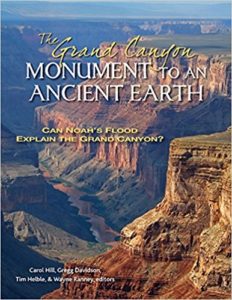Previous posts summarized Whitcomb and Morris’ classic Global Flood Model and Snelling’s modern update. (Part 1) (Part 2) (Part 3) This post covers critiques of these models given by other Christian geologists, particularly as given by Davis Young and Ralph Stearley. These criticisms can be grouped under five broad headings:
The Preponderance of Geological Evidence Does Not Support the Global Flood Model: Critics of the global flood theory contend that the facts simply go against the model. In The Bible, Rocks, and Time, geologists Davis Young and Ralph Stearley present a survey of the cumulative evidences for an ancient earth. They contend that the multitude of data they present cannot be explained by a single catastrophic flood. Other old-earth advocates concur.
They contend that the multitude of data they present cannot be explained by a single catastrophic flood. Other old-earth advocates concur.
For example, consider the claim made by global flood adherents that the geological column presents different geographical regions rather than different chronological time periods. As we noted earlier, there are four broad geological divisions: the Precambrian, the Paleozoic, the Mesozoic, and the Cenozoic, with the oldest (Precambrian) located at the bottom and the youngest (Cenozoic) setting on top. This sequence is found worldwide. The global flood model holds that these four systems were four contemporary, geographically distinct regions. Charles Foster contends that if the global flood model were correct, the fossil record world look different. He explains,
“If one looked at the fossils from a contemporary rain forest, a contemporary coral reef, and a contemporary city, one would see very different things. Well, true, but if they were contemporary but geographically separated, they would not lie neatly on top of one another, always in the same order wherever one looked in the world. If the creationists were right, you would find a mass of Paleozoic fossils in Europe, a mass of Mesozoic fossils in North America, and so on. But you do not. The problem is compounded for the creationist since the flood is supposed to have buried everything at the same time.” (2009:55-56)
After analyzing Snelling’s argument that the geologic column was created during the flood, Timothy Heble concludes, “When one considers the math of lateral sediment transport necessary to form 4,000 feet of sedimentary strata in 150 days over hundreds of thousands of square miles, the implausibility of Flood geology becomes easier to comprehend.” (2011:30)
An Approach that Completely Rejects the Field of Geology: A report by the National Academy of Sciences sums up in one sentence why mainstream geologists reject the global flood model: “The belief that Earth’s sediments, with their fossils, were deposited in an orderly sequence in a year’s time defies all geological observations and physical principles concerning sedimentation rates and possible quantities of suspended solid matter.”
Mainstream geologists argue that flood geologists are forced to make ever more elaborate and unlikely scenarios (such as appeals to underground reservoirs of sediments and water for which there is little or no empirical evidence, selective use of mainstream research, appeals to the suspension of the laws of nature, and resorting often to special pleading). In short, proponents of a global flood are the geological equivalent to Ptolemaic astronomers. Pre-Copernican astronomers found it necessary to add ever more complicated epicycles to get the Ptolemaic model to resemble the empirical evidence. Copernicus recognized that Ockham’s Razor required a paradigm shift (Ockham’s Razor is the scientific principle that, all things being equal, the simplest solution is generally the correct one). So astronomers abandoned the Ptolemaic earth-centered model in favor of the Copernican sun-centered model. Critics contend that at some point flood geologists need to do the same thing.
The field of geology cannot be “tweaked” to accommodate a global understanding of Noah’s flood. Geology, as currently understood, would have to be completely rejected and overthrown. As Francis Collins observes,
“In general, those who hold [YEC] views are sincere, well-meaning, God-fearing people, driven by deep concerns that naturalism is threatening to drive God out of human experience. But the claims of Young Earth Creationism simply cannot be accommodated by tinkering around the edges of scientific knowledge. If these claims were actually true, it would lead to a complete and irreversible collapse of the sciences of physics, chemistry, cosmology, geology, and biology.” (2006: 173-74; Tim Heble’s article pointed me to this quote)
As Collins puts it, the global flood model cannot be incorporated into the field of geology simply by “tinkering around the edges.”
A Methodology of Embracing Outliers While Rejecting the Main Body of Evidence: Old-earth geologists accuse flood geologists of selectively choosing the data from mainstream sources. Helble states, “When YECs draw on material from the mainstream science community, other information that contradicts the young earth position can often be found in the same cited references.” Young and Stearley are more explicit in their criticism of the approach taken by global flood advocates:
“Because they have put on blinders, young-Earth creationists are unwilling to accept the totality of the available geologic evidence. They are unwilling to abandon their young-Earth, global-Flood hypothesis even when the evidence shows it to be untenable. They have ignored or distorted a vast body of evidence that is contrary to their preconceived notion of what Earth history must have been like. They have focused only on data that, taken in isolation from geologic contexts, might be seen as favorable to their own theory. They claim continually to argue from the evidence of nature, but they have repeatedly ignored what is inconvenient for them. Although some of the phenomena of the sedimentary rock record might be interpretable in terms of a great Flood, most of the phenomena to which they appeal are far more satisfactorily explicable in terms of much smaller scale processes than a global catastrophic Flood. More important, young-Earth creationists have refused to accept the abundant evidence of glacial deposits, lake deposits, desert deposits, delta deposits, shore deposits, reef deposits, and evaporate deposits in the rock record. Young-Earth creationists have refused to face the evidence from metamorphism, the kinetics of mineral formation and heat flow from cooling magmas. Then have tried to make the evidence from radiometric dating say something opposite form what it does say. The attempt to find a way to have the decay constants of radioactive isotopes change in an unbelievably spectacular fashion is a desperate attempt to rescue their view of the world. To date, all physical evidence pertaining to decay constants indicates the virtual immutability of those constants [emphasis original]. Although a tiny fraction of geologic evidence might suggest a global Flood if considered in complete isolation from the wealth of other evidence, the overwhelming totality of evidence argue mightily against a global Deluge.” (472-73)
Biblical scholars can understand the nature of the complaint above. When someone uses an obscure passage of Scripture to come to a conclusion that is contrary to the clear teaching of the rest of the Bible, then that one is accused of mishandling the sacred text. Young and Stearley are making a similar accusation against the way global flood advocates interpret the geological evidence.
Presuppositional Bias? Snelling repeats the assertion made by Whitcomb and Morris that the presuppositions held by mainstream geologists prevent them from considering the global flood model. Those who decide to embrace assumptions that go against the young-earth model and flood geology reveal a decision to throw off the authority of Scripture. “The bias exhibited by one’s choice of assumptions may not simply be a matter of objective science, but rather primarily of one’s subconscious spiritual condition.” (295-97) However, many, if not most, geologists of the early 19th century were Christians who held to a high view of the Bible. These geologists gave up flood geology only reluctantly, and then only after they were convinced that the empirical evidence left them with no choice. As early as 1834, long before Darwin published his theory, an article in the Christian Observer lamented that Christian geologists felt they were intellectually compelled to abandon flood geology:
Those who decide to embrace assumptions that go against the young-earth model and flood geology reveal a decision to throw off the authority of Scripture. “The bias exhibited by one’s choice of assumptions may not simply be a matter of objective science, but rather primarily of one’s subconscious spiritual condition.” (295-97) However, many, if not most, geologists of the early 19th century were Christians who held to a high view of the Bible. These geologists gave up flood geology only reluctantly, and then only after they were convinced that the empirical evidence left them with no choice. As early as 1834, long before Darwin published his theory, an article in the Christian Observer lamented that Christian geologists felt they were intellectually compelled to abandon flood geology:
“Buckland, Sedgwick, Faber, Chalmers, Conybeare, and many other Christian geologists, strove long with themselves to believe that they could: and they did not give up the hope, or seek for a new interpretation of the sacred text, till they considered themselves driven from their position by such facts as we have stated. If, even now, a reasonable, or we might say POSSIBLE solution were offered, they would, we feel persuaded, gladly revert to their original opinion” [emphasis original]. [BTW, this quote is from Philip Gosse’s Omphalos: An Attempt to Untie the Geological Knot, 1857: 5-8. Gosse published before Darwin’s Origin of Species, and was the first to make the “appearance of age” argument.]
The Bible-believing geologists of the 19th century were driven by the geological findings to the conclusion that the earth is ancient and that Noah’s flood cannot account for those findings. They resisted this conclusion, and did not come to it happily. They certainly were not motivated by an atheistic agenda nor were they blinded by naturalistic presuppositions.
The Accusation of Fideism Parading as Science: To account for evidence that goes against YEC in general and the global flood model in particular, Snelling suggests that God supernaturally intervened to change the laws of nature during the flood event. Young and Stearley, as fellow evangelicals, acknowledge that they, in principle, have no problem with an appeal to the miraculous. However, they contend that this puts the event beyond scientific investigation and defense.
“The only recourse that flood catastrophists have to save their theory is to appeal to a pure miracle and thus eliminate entirely the possibility of historical geology. We think that would be a more honest course of action for young-Earth advocates to take. Young-Earth creationists should cease their efforts to convince the lay Christian public that geology supports a young Earth when it does not do so. To continue that effort is misguided and detrimental to the health of the church and the cause of Christ.”
Davis and Stearley conclude that the entire “flood geology” enterprise is invalid as a scientific endeavor.
(This excerpt is from 40 Questions about Creation and Evolution, coauthored by Mark Rooker and me. Since the publication of our book, another excellent text has been published by old-earth geologists: The Grand Canyon: Monument to an Ancient Earth.
Since the publication of our book, another excellent text has been published by old-earth geologists: The Grand Canyon: Monument to an Ancient Earth. This book is layperson-friendly and I highly recommend it.)
This book is layperson-friendly and I highly recommend it.)


Great article! Such and important issue to bring to light.